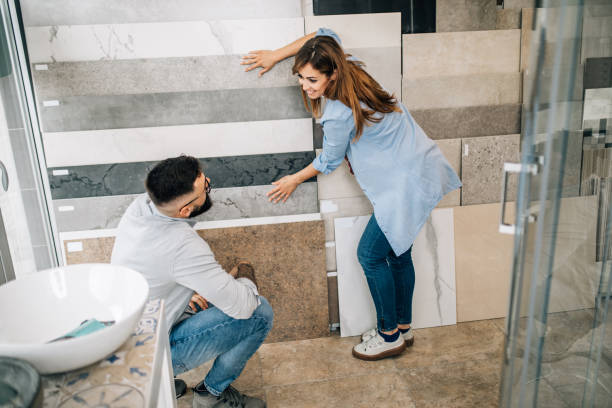How to Choose Bathroom Tiles-A Complete Guide

- When remodeling or building a new bathroom, you’ll have many options to choose from. One is the tile that you think will be most pleasing. You will notice them first because they are the ones who set the tone of the space.
The vast selection of tiles can quickly turn into indecision. Which is better, a darker or lighter tone? Is it better to have a small or a large size? Glossy or matte? Smooth and modern, or organic and textured?
This can easily turn that happiness into anxiety and stress about making the best decisions. You will be happy with your choices for many years to come if you follow this path.
Select the Right Material
The durability and design possibilities of Glassed vitrified tiles are the best among all tile materials. These tiles are resistant to stains and odors and will not allow bacteria to grow. These are great for bathrooms with a lot of traffic.
Vitrified tiles offer a wider range of colors and patterns for a sleeker, more opulent look. The following are some of the characteristics that make vitrified tiles perfect for bathroom floors:
- Resistant to moisture buildup (water condensation)
- Germfree resists bacteria and pathogens (Germfree).
- Maintainable
- Design options are numerous
- Comparable to other materials, this material is quite affordable
Select the Right Appearance
Glossed Vitrified Tiles or Digital GVT tiles are the best in terms of appearance and functionality. Tiles are also known for their durability. GVT tiles can have designs that look like slate, wood, stone, or any other natural material.
GVT Tile collection includes finishes such as high gloss, satin matte, and rocker. In both commercial and residential settings, high gloss and satin matte finishes are popular. GVT tiles are available in a variety of finishes.
- Poplar Beige
- Cementum Gris
- Nice Pearl or White Pearl
- Amazon Bottochino
Select the Right Finish
The different spaces inside and outside a house or building require other surfaces. With a variety of surface finishes and glazes, vitrified tiles can solve the utility issue.
1. Add Texture
If you’re looking to create a spa atmosphere in your bathroom, a tile inspired by nature is a great choice. These materials all have a natural look: slate, travertine tiles, marble effect tiles, and stone effect tiles. Combine these textures with wood tones for a refreshing and energizing result.
2. Smooth Finishes
A smooth tile is always easier to clean. Water can collect more readily on tiles that are deeply embossed, tiles with natural dips and crevices, or pebble tiles. You may have to be more careful with your cleaning program. When choosing tiles for your bathroom, consider your ability to maintain the tile throughout its lifetime.
3. Marble Effect Tiles
Interior designers say that marble is currently the most popular type of stone. The beautiful and striking veining adds individuality to any wall. The downside of natural marble is that it is expensive and requires regular sealing and maintenance. This is why alternatives that mimic the look of natural marble are becoming more popular.
4. Cement Tiles
Natural appearances or “bringing the outside in” are the biggest interior design trend in the world. The key to creating a calm atmosphere in your home is to bring in natural elements.
5. Wood Effect Split Face Tiles
Reclaimed wood can be defined as wood that is taken from one environment and used for flooring or furniture. Reclaimed wood is unique and appealing due to the many colors, textures, and finishes that it produces. These Wood Effect Split Face tiles replicate the beauty of salvaged timber without the cost.
Select the Right Size
You can use different types of tiles to mark areas if you have enough space. If you have the space, you can use different types of tiles for the floor or tiles for the walls.
1. The Room
If your bathroom is small, it’s best to avoid using large format tiles. It would be best if you chose tiles that are suitable for the size of your room. For example, mosaic tiles would be ideal for a small cloakroom, and tiles in a medium bathroom. Check out our How to Choose The Right Size Tiles feature if you need help.
2. Shower Area
It would be best if you generally used tiles or pans that have a slope to allow for proper water drainage. This area should be between 30x30cm and 60x60cm, depending on the size of your bathroom. Tiles up to 60x120cm can be used in larger bathrooms.
The best tiles for shower walls and floors are glazed vitrified tiles. It is important to use tiles that are small enough for the floor to have soft contours. This will allow the water to flow properly towards a central drainage and prevent slush buildup.
Tiles in the shower area should have anti-slip properties for better grip. Smaller tiles require more seams, requiring more grout lines. The need for more grout lines increases the maintenance required and the risk of seepage. Shower floor tile installation requires a delicate balance between tile size and slope, as well as the overall look of the area.
3. Bathroom Wall Tile
Tiles larger than 30x30cm look best on bathroom walls. You can choose between 30x45cm and larger sizes, such as 60x120cm, for larger bathrooms. For bathroom walls, rectangular tiles such as 30x45cm and 60x120cm are ideal when covering the wall to the ceiling. Tiles of larger sizes can be laid in a horizontal pattern for better fitting and appearance.
Subway tiles are popular in bathrooms as well because they also have a 2:1 size ratio. Listellos are a great option for tiles that need to be as long as possible but as narrow as they can be. These decorative tiles are often used to separate two panels of wall tiles.
Calculate the Quantity You Need (area and method of calculation)
You can use the u>a href=”https://www.hrjohnsonindia.com/tiles-calculator”>tile calculator/a>/u> for the same and take care of the following: Use the tile calculator to do the same.
1. Outstanding Tile
Choose a design that you love and use it as a guide when choosing your bathroom tiles. You may have fallen in love with a particular format, a vibrant color, or an interesting shape. You can use this tile to add drama to your shower enclosure or flooring, as well as to accent walls. Decide on accent tiles by using the standout tile as your guide.
2. Comfort
If you plan to use tiles on your shower floor, make sure that you choose something comfortable and secure to avoid slipping. In general, you should select small tiles or mosaics in this area. The extra grout lines will increase the area’s slip resistance without irritating your feet.
3. Layout of the Tiles
It’s important to remember that a simple tile doesn’t have to be boring. You can add some uniqueness to your design by arranging metro or rectangular tiles in an interesting arrangement. Our post on tile-laying techniques has many great ideas.
The bathroom flooring has the most variety, from large to mosaic and digital prints to natural colors. Keep in mind the coefficient of friction (COF) number. The manufacturers of tiles list the Coefficient of Friction ratings (COF) for each tile on their website and in printed material. A higher COF indicates better surface resistance.
The most common and recommended tiles for bathroom floors are ceramic and vitrified tiles that have a rating of 0.42. Mosaic tiles are often used in bathrooms because of their excellent grip and the seaming they offer for wet or dry feet. These tiles are able to replicate mosaic tile patterns with ease.
This size tile will also result in an acceptable number of full-size ceramic tiles, even in a tiny bathroom. Small bathrooms and powder room look fantastic with tiles that are 4 inches by 4.
Before deciding to use large format tiles in your bathroom, you should determine the square footage. You can then calculate the number of full-size tiles you will need.




Leave a Reply